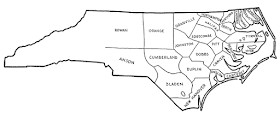

So, looking at the inventories, what was available for women to stay warm on these damp and cool days. There was a variety of textile available for women to make gowns out of during the 18th century. Callimanco, Duroy, Crape, Camblet, Stuff, Saggathy, Grazet and Worsted are all mentioned in the estates of women in North Carolina as a textile for gowns.
Mary Stubbs in 1738 listed a callimanco gown among others in her inventory. The Dreamstress has a great article about what exactly is callimanco. Callimanco is defined as "a worsted 'stuff' . . . [with]a fine gloss upon it. Callimancos are of all colours, . . .some are quite plain, and other have broad stripes, adorned with flowers, some with plain broad stripes, some with narrow stripes, and other watered. (Montgomery, 185). Unfortunately, there are no vendors currently carrying callimanco in their stores. Maybe that will change.
Then we come across the textile Duroy in the inventories of Mary Glouster/Glaister in 1740 and in Elizabeth Montague's 1756 inventory. Note both of these ladies were early Quaker settlers in the northeast portion of North Carolina. Duroy is a "lightweight worsted material generally used for men's clothing." (Montgomery, 230). However in the case of Elizabeth Montague, she specifically said for duroy to be purchased from her estate to make the gown.
| "Item. I give to Naomy Newby wife of James Newby, Duroys for a gound to be bought from my Estate." Elizabeth Montague's will 1756, Perquimans County, North Carolina |
Crape gowns are mentioned in three inventories: Elisebeth Handcock (1743 Craven County); Alice Whitehead (1743 Craven County); and Elizabeth Montague (1756 Perquimans County). Crape is defined as " a light transparent stuff, in the manner of gauze, made of raw silk, gummed and twisted on the mill; wove without crossing and much used in mourning." Other crapes were made of worsted and sometimes mixed with silk. (Montgomery, 207). I am guessing these three are the worsted types since they do not list them as "silk crape" like in the inventory of Lawrence Mague (1740 Bertie County) that lists a silk crape gown and coat. (probably his late wife's.)

 |
| Imported good from Samuel Cornell in Newbern, NC 1764. "The Newbern Gazette" 02 November, 1764 (Newspapers.com) |
Camblet gown is listed in Anne Pollard (1750 New Hanover County). Camblet example from Burnley & Trowbridge. I actually have a bedgown completed and a gown cut out to be made from their Camblet. Camblet was very popular for clothing during this time. Numerous runaway advertisements in newspapers list camblet or camlet gowns being worn all up and down the East Coast. We also see camblet imported and sold in North Carolina at the store of Samuel Cornell of New Bern, NC.
Margaret Prichett bequeathed a stuff gown to her "grand daughter Margaret Prichett" Interestingly enough, this gown is absent from another version of the will. No color description of the gown but nonetheless, a woolen gown can be very warm on a damp winter day.
| Will of Margaret Prichett (1756 - Beaufort County) |
 |
| Inventory of Rachel Hill (1763 Carteret County) |
The inventory of Rachel Hill is very interesting on several levels. Of her six gowns she has in her estate, two are of a woolen material. "Saggethe" and "Grapset".
Saggathy is listed as "a slight woolen stuff of twill weave, a kind of serge or ratten sometimes mixed with a little silk." (Montgomery, 337) As you notice in the list of imported goods in Samuel Cornell's store, saggathie is listed. I have seen other references to saggathy in North Carolina.
Grapset or Grazet is similar material. Grazet can be found as early as 1732 in Pennsylvania. What is interesting about Rachel's inventory is that there is a gown, petticoat and a bonnet all made from grazet.
And then we round out the list of woolen gowns with Ann Eborn's estate in 1769 of a "worsted gown"
So when you are trying to decide on if a woolen gown is appropriate in the south, the answer is yes. If you notice that all of these textiles are considered a "lightweight" and not a heavy wool like say serge, broadcloth or etc. I don't think you could make a gown out of something of a heavy material. Plus living and working on the water, there are many days that the temperatures are 10-15 degrees cooler than up in "town." Even in the late spring, you could still comfortably wear a woolen gown based off of experimental archaeology. Have a great weekend!
References:
Textiles in America, 1650-1870: A Dictionary Based on Original Documents, Prints and Paintings, Commercial Records, American Merchant's Papers, Shopkeepers' Advertisements, and Pattern Books with Original Swatches of Cloth by Florence Montgomery.
If you don't have this book - I highly recommend getting a copy somehow. It is the bible of historical textiles.









